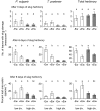Herbivory of an invasive slug is affected by earthworms and the composition of plant communities
- PMID: 23668239
- PMCID: PMC3656784
- DOI: 10.1186/1472-6785-13-20
Herbivory of an invasive slug is affected by earthworms and the composition of plant communities
Abstract
Background: Biodiversity loss and species invasions are among the most important human-induced global changes. Moreover, these two processes are interlinked as ecosystem invasibility is considered to increase with decreasing biodiversity. In temperate grasslands, earthworms serve as important ecosystem engineers making up the majority of soil faunal biomass. Herbivore behaviour has been shown to be affected by earthworms, however it is unclear whether these effects differ with the composition of plant communities. To test this we conducted a mesocosm experiment where we added earthworms (Annelida: Lumbricidae) to planted grassland communities with different plant species composition (3 vs. 12 plant spp.). Plant communities had equal plant densities and ratios of the functional groups grasses, non-leguminous forbs and legumes. Later, Arion vulgaris slugs (formerly known as A. lusitanicus; Gastropoda: Arionidae) were added and allowed to freely choose among the available plant species. This slug species is listed among the 100 worst alien species in Europe. We hypothesized that (i) the food choice of slugs would be altered by earthworms' specific effects on the growth and nutrient content of plant species, (ii) slug herbivory will be less affected by earthworms in plant communities containing more plant species than in those with fewer plant species because of a more readily utilization of plant resources making the impacts of earthworms less pronounced.
Results: Slug herbivory was significantly affected by both earthworms and plant species composition. Slugs damaged 60% less leaves when earthworms were present, regardless of the species composition of the plant communities. Percent leaf area consumed by slugs was 40% lower in communities containing 12 plant species; in communities containing only three species earthworms increased slug leaf area consumption. Grasses were generally avoided by slugs. Leaf length and number of tillers was increased in mesocosms containing more plant species but little influenced by earthworms. Overall shoot biomass was decreased, root biomass increased in plant communities with more plant species. Earthworms decreased total shoot biomass in mesocosms with more plant species but did not affect biomass production of individual functional groups. Plant nitrogen concentrations across three focus species were 18% higher when earthworms were present; composition of plant communities did not affect plant quality.
Conclusions: Given the important role that both herbivores and earthworms play in structuring plant communities the implications of belowground-aboveground linkages should more broadly be considered when investigating global change effects on ecosystems.
Figures


References
-
- United Nations Environment Programme. Millennium Ecosystem Assessment. In: Cleveland CJ, editor. Encyclopedia of Earth. Washington, DC, USA: Environmental Information Coalition, National Council for Science and the Environment; 2006.
-
- Schulze ED, Mooney HA. Biodiversity and ecosystem functioning. Berlin, Germany: Springer-Verlag; 1994.
-
- Loreau M, Naeem S, Inchausti P. Biodiversity and ecosystem functioning - Synthesis and Perspectives. New York, USA: Oxford University Press; 2002.
-
- Fargione JE, Tilman D. Diversity decreases invasion via both sampling and complementarity effects. Ecol Lett. 2005;8:604–611. doi: 10.1111/j.1461-0248.2005.00753.x. - DOI
-
- Elton CS. The ecology of invasions by animals and plants. London, UK: Methuen; 1958.
Publication types
MeSH terms
Grants and funding
LinkOut - more resources
Full Text Sources
Other Literature Sources
Research Materials
Miscellaneous

